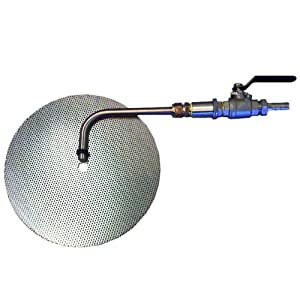You are using an out of date browser. It may not display this or other websites correctly.
You should upgrade or use an alternative browser.
You should upgrade or use an alternative browser.
sanke mash tun dead space
- Thread starter jmc922
- Start date

Help Support Homebrew Talk - Beer, Wine, Mead, & Cider Brewing Discussion Forum:
This site may earn a commission from merchant affiliate
links, including eBay, Amazon, and others.
runningweird
Well-Known Member
I think of dead space as the amount of air space between the top of the mash and the top of the mash tun. It sounds like you need to makebuy a dip tube. With a false bottom you can have the dip tube just above the bottom of the keg and get almost all the liquid.




runningweird
Well-Known Member
also keep in mind that the goal should not be to get as much out of the tun as possible but instead to get a certain volume of wort at a certain specific gravity to fit with your chosen recipe/idea. There is always liquid left in the mash because the grain acts like a sponge- which is why we must account for grain absorption - if you are concerned about waste strain out the leavings, boil them down separately and use them for yeast starters.
Hello there
I had a similar question and looking at your posts confused me. I just want to be clear since I will be brewing with a 15.5 gal keg with false bottom (RIMS) setup in the near future.
So, if I have a dead space that collects .5 gal below my False Bottom and I use a 1.5 qt/lbs factor as my mash-in (water volume) formula then I would need ((X lbs)*(1.5 qt/lbs)) + 2 qts (dead space volume)….correct?
Also, I need to mention that my mash-tun is equipped with a siphon (as pictured above) that will collect all the wort from below the false bottom (even during recirculation and fly spare)….
Thanks in advance for your help
I had a similar question and looking at your posts confused me. I just want to be clear since I will be brewing with a 15.5 gal keg with false bottom (RIMS) setup in the near future.
So, if I have a dead space that collects .5 gal below my False Bottom and I use a 1.5 qt/lbs factor as my mash-in (water volume) formula then I would need ((X lbs)*(1.5 qt/lbs)) + 2 qts (dead space volume)….correct?
Also, I need to mention that my mash-tun is equipped with a siphon (as pictured above) that will collect all the wort from below the false bottom (even during recirculation and fly spare)….
Thanks in advance for your help
Be careful with terminology.
Liquid tied up in the grain is absorption loss.
Liquid that is in the bottom of the tun that cannot be drained because it is below the drain port or below the opening of a siphon tube is called dead space.
The volume below a false bottom is not exactly dead space since a siphon tube can subtract that volume as dead space. However, it does affect the apparent mash thickness since the grain stays above it. I'd call this foundation water space or "slack space".
The ideal situation is to have zero dead space and a minimal volume of slack space. If you direct fire it though, a gallon of slack space is reasonable. .5 gallons is not a lot of liquid in the scheme of a typical mash. The mash will just appear a tiny bit thicker.
Liquid tied up in the grain is absorption loss.
Liquid that is in the bottom of the tun that cannot be drained because it is below the drain port or below the opening of a siphon tube is called dead space.
The volume below a false bottom is not exactly dead space since a siphon tube can subtract that volume as dead space. However, it does affect the apparent mash thickness since the grain stays above it. I'd call this foundation water space or "slack space".
The ideal situation is to have zero dead space and a minimal volume of slack space. If you direct fire it though, a gallon of slack space is reasonable. .5 gallons is not a lot of liquid in the scheme of a typical mash. The mash will just appear a tiny bit thicker.
Similar threads
- Replies
- 0
- Views
- 227
- Replies
- 0
- Views
- 271
- Replies
- 0
- Views
- 338

